
In industrial production, drying of calcium chloride dihydrate and anhydrous calcium chloride is relatively difficult due to the following challenges:
1. The drying process of calcium chloride involves a melting process.
Generally, calcium chloride has different solubilities at different temperatures, and flake calcium chloride production typically involves a cooling process. Therefore, in the drying and heating process, it must go through a temperature rise process from low to high, inevitably passing through the dissolution temperature, dissolving in the water it carries, causing particles to stick together, and easily forming lumps, which can cause troubles in the drying process.
2. The dehydration temperature is high.
At standard pressure, the melting point of a saturated solution of calcium chloride dihydrate is around 170℃, and flake calcium chloride is generally obtained by cooling in a flaker. Calcium chloride dihydrate only becomes anhydrous calcium chloride when heated to 260℃. Therefore, the inlet air temperature during drying is generally higher than 260℃ and a certain drying time is required.
3. Special calculation is required.
Unlike calculating the dehydration of surface water, when calculating the required heat for drying and dehydration of calcium chloride, it is necessary to consider the amount of crystalline water and the heat generated by the removal of crystalline water.
We supply complete calcium chloride production plants, 75% calcium chloride dihydrate, 95% anhydrous calcium chloride, and flaky and granule as per specific requirement. Our process has the following advantages:
a.The preparation of the calcium chloride solution in the reaction refinement section is realized through continuous operation, which completely solves the problem of non-compliant exhaust gas emissions.
b. Each exhaust emission point in the entire process adopts a multi-stage dust and mist removal structure, and the emissions meet environmental protection requirements.
c. The spray granulation and drying system process is fully automated, and no need of manual operation at solid feeding post.
d. The thermal efficiency of the system equipment is high, and can reach over 90%.
Contact Us
Pls feel free to reach out for proposals

